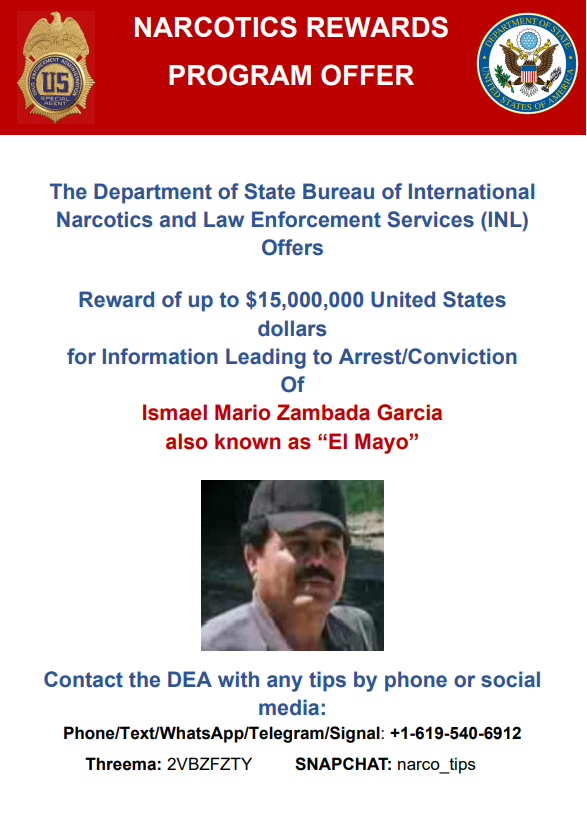
Ismael "El Mayo" Zambada García, born in Culiacán in January 1948, has been a legendary figure in the world of drug trafficking. For decades, he was one of the most prominent leaders of the Sinaloa Cartel, a position that made him a top target for both Mexican and U.S. authorities. Despite numerous efforts to apprehend him, El Mayo managed to evade capture—until today, when reportedly he voluntarily turned himself in to the U.S. Drug Enforcement Administration (DEA).
According to the Mexican press and the news agency Reuters, Zambada and Joaquín Guzmán jr., one of El Chapo Guzmán sons, surrendered at an airport in El Paso, Texas, marking the end of one of the longest and most elusive manhunts in the history of drug enforcement. His surrender brings a significant chapter in the fight against drug trafficking to a close.
Who is El Mayo Zambada?
El Mayo's criminal record is extensive, with his involvement in the drug trade dating back to the 1970s. Over the years, he has been implicated in multiple federal cases in the United States, accused of facilitating the trafficking of cocaine and marijuana into the country. Following the capture of his infamous counterpart, Joaquín "El Chapo" Guzmán, El Mayo inherited the mantle of leadership within the Sinaloa Cartel, solidifying his status as a kingpin.

Born in Sinaloa, El Mayo began his life in the drug trade as a teenager. Over the decades, he ascended to the top echelons of the Mexican narcotics hierarchy, especially after the arrest of Miguel Ángel Félix Gallardo in 1989. Since then, his name appeared in U.S. intelligence reports as a key figure in the Sinaloa Cartel, alongside El Chapo and Juan José Esparragoza Moreno, also known as "El Azul."
The story of how it happened was fictionalized in Netflix's "Narcos México." El Mayo's character was identified as Mr Ismael.
The pursuit of El Mayo has intensified in recent years, especially as the U.S. faced a growing crisis related to fentanyl, a potent opioid that has led to over 100,000 deaths annually. U.S. authorities pointed to major Mexican drug organizations, particularly the Sinaloa Cartel, as primary traffickers of this deadly substance.
In response, federal prosecutors launched new charges against Zambada, accusing him of manufacturing and distributing fentanyl, exacerbating the urgency of his capture.
Despite his long-standing involvement in drug trafficking, the DEA noted a remarkable fact about El Mayo Zambada: until today, he had never spent a day in prison. His ability to remain at large contributed to his legendary status, fueled by a life of evasion, secrecy, and survival.
El Mayo about his capture
In 2010, Julio Scherer, a respected Mexican journalist, managed a rare encounter with Zambada. The meeting took place in a secluded, rustic house, and while the interview was sparse on details, Scherer described El Mayo: "He stands over 1.80 meters tall and has a body like a fortress, despite a barely noticeable belly. He wears a t-shirt, and his blue jeans maintain the straight line of well-ironed clothes. He covers himself with a cap, and his trimmed mustache suggests a subtle and permanent irony."
During the interview, they talked about the posibility of being captured.
"One day, I decide to surrender to the government to be executed. My case must be exemplary, a warning to all. They execute me, and euphoria erupts. But after a few days, we come to realize that nothing has changed.
–Nothing, even with the kingpin fallen?
–The problem of narco-trafficking involves millions. How can they be controlled? As for the kingpins, whether imprisoned, dead, or extradited, their replacements are already out there."
A family affair
El Mayo's family had also felt the reach of law enforcement. His son, Vicente Zambada Niebla, was arrested in 2009 on charges of organized crime and extradited to Chicago in 2013. Known as "Vicentillo," he pleaded guilty and cooperated with authorities, providing crucial testimony that helped convict El Chapo Guzmán. Vicente was sentenced to 15 years in prison but was released in 2021.
Most recently, in February, U.S. federal prosecutors accused Zambada of conspiracy to manufacture and distribute fentanyl. This potent drug is now the leading cause of death for Americans aged 18 to 45. Zambada faced a litany of federal charges, including drug trafficking, money laundering, violent crimes in aid of racketeering, and even murder.
The hunt for El Mayo was not just a priority for Mexico but also for the United States, which labeled him as a major orchestrator of fentanyl trafficking. In light of his significant role in the opioid crisis, the U.S. government offered a $15 million reward for information leading to his capture. This made Zambada one of the most sought-after men in the world. He managed to avoid them until he turned himself in on July 25th, 2024.

© 2025 Latin Times. All rights reserved. Do not reproduce without permission.





